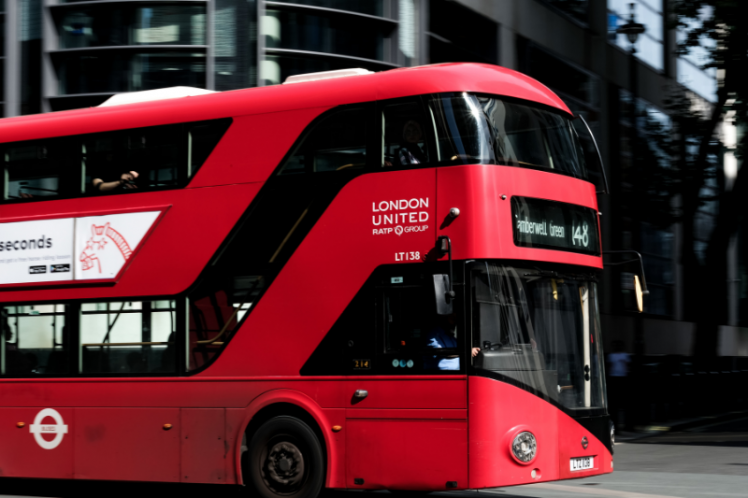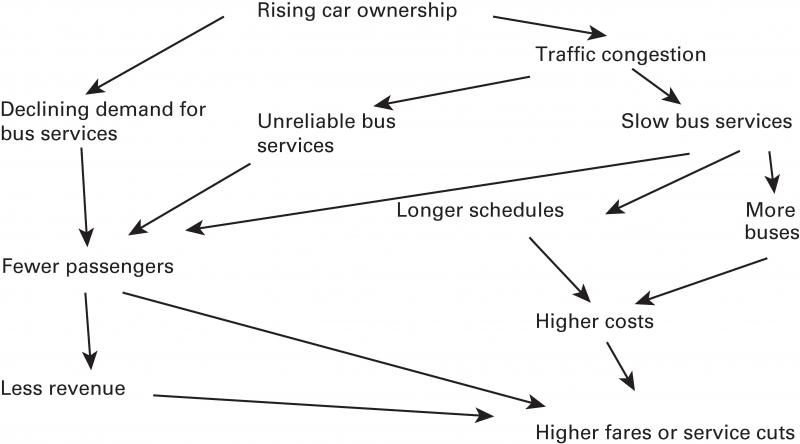Road Transport: The Case for Buses as a Priority

This is an exclusive extract from Road Passenger Transport Management.
Buses are very efficient users of road space. Research about ‘people-moving’ in London in 1990 found that during peak periods buses carried one-third of road passengers, but only accounted for 1% of road vehicles (Hurdle, 1990).
In terms of fuel used per passenger mile, research, again in 1990, found that a bus, half full of passengers, was about four to seven times more efficient than a car (average 1.5 persons) in urban conditions (Adams, 1990); a bus only one-third full could still be two to six times more efficient, depending on the size of the vehicles (Trades Union Congress, 1990).
The need for bus priority measures stems from the, often slow, speed of buses at peak times, and congestion that makes services irregular, unreliable, and unattractive to use. If journeys take longer this clearly increases the cost of operation. A spiral of decline arises, best explained in Figure 11.1.

SOURCE Buchanan, 1990
Of course, road space does not belong to the bus operator; and it does have to be shared with many forms of transport. But it is a scarce resource, and if buses are efficient users of road space it makes sense to prioritize their use of it and so maximize efficient operation and attractive services. There are three other powerful reasons.
The first is environmental. Air pollution in many cities has been at illegal levels since 2010 and traffic is the main source (Carrington, 2018). In the case of nitrogen dioxide, 38 zones covering 194 local authorities exceeded legal limits in 2014 (Department of the Environment, Food and Rural Affairs, 2015). In 2015, London was 15th out of 36 major global cities in terms of overall air quality, behind other European cities such as Stockholm, Vienna and Berlin (Quilter-Pinner and Laybourn-Langton, 2016). Buses, and coaches, account for just 6% of nitrogen oxide emissions from road transport compared with 71% from diesel cars and vans (Begg, 2017). So, more bus use, and less car use, will contribute to reducing levels.
The second is also environmental – climate change. Following the Climate Change Act of 2008 and subsequent legislation, there is now a ‘climate change emergency’ and carbon dioxide emissions need to be eliminated as soon as possible. The warnings are stark – the Intergovernmental Panel on Climate Change (IPCC) has warned that:
- the world has already warmed by 1°C since the middle of the 19th century;
- warming could reach 1.5°C before 2050;
- the world is on track for a 3°C rise;
- to meet a goal of 1.5°C warming, the planet’s emissions need to be 45% below 2010 levels by 2030 (IPCC, 2018).
The report is the most up-to-date and comprehensive explanation of the science of climate change and the future of the Earth, compiled by 91 authors and 133 contributing authors, from 40 countries, with 30,000 assessed scientific papers and over 42,000 comments made during its review (Cool Earth, 2019).
An influential activist in 2019 put it more starkly: ‘Around the year 2030 … we will be in a position where we set off an irreversible chain reaction beyond human control, that will most likely lead to the end of our civilization as we know it. That is unless, in that time, permanent and unprecedented changes in all aspects of society have taken place, including a reduction of carbon dioxide emissions by at least 50%’ (Thunberg, 2019). Again, a shift from car to bus use will contribute.
The third reason is that buses are a short-term way of increasing capacity on public transport. Trains in cities can be overcrowded and it can take many years to increase capacity on railways.
So, the case for bus priority comprises:
- efficient use of road space in terms of fuel and people movement;
- air pollution and climate change dictate a significant shift from car to bus use;
- a short-term solution to increasing capacity of public transport.





